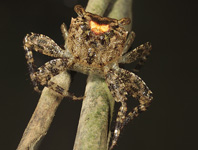Abstract
The validity and necessity of subspecies as a taxonomic category and the implications of the subspecies concept in various taxa of animals is subject of debates since its very existence. In case of the species of the lygaeoid subfamily Geocorinae there are multiple examples of species consisting of up to nine subspecies which were mostly described as varieties or forms before the middle of 20th century, but upgraded to valid subspecies subsequently, usually without providing any arguments. As part of an integrated taxonomic study on the Palaearctic representatives of Geocorinae, the status of the subspecies of Geocoris (Piocoris) erythrocephalus (Lepeletier & Serville, 1825) was revisited. A critical review of the literature available and our studies, involving analysis of COI sequences, morphological examination and distribution data processing with the use of Geographic Information System, concluded that two of the three subspecies, G. e. erythrocephalus and G. e. marginellus Horváth, 1907, can be considered valid, while G. e. litoreus Horváth, 1895, is merely a phenotypically manifested infrasubspecific genetic variety of G. e. erythrocephalus, with no taxonomic value as it was suggested by earlier study of another author. Besides the interpretation of evidence, the applicability of the subspecies concept in Geocorinae is discussed as well.
References
Arino, O., Ramos, J., Kalogirou, V., Defourny, P. & Achard, F. (2010) GlobCover 2009. ESA Living Planet Symposium, 27 June–2 July 2010, Bergen, Norway, 1–3. Available from: http://epic.awi.de/31046/1/Arino_et_al_GlobCover2009-a.pdf (accessed 24 April 2018)
Felsenstein, J. (1985) Confidence limits on phylogenies: An approach using the bootstrap. Evolution, 39, 783–791.
https://doi.org/10.2307/2408678
Gillham, N.W. (1956) Geographic variation and the subspecies concept in butterflies. Systematic Zoology, 5 (3), 110–120.
https://doi.org/10.2307/2411573
Dellapé, P.M. & Henry, T.J. (2018) Geocoris (Piocoris) erythrocephalus (Lepeletier & Serville, 1825). Lygaeoidea Species File. Version 5.0/5.0. Available from: http://Lygaeoidea.SpeciesFile.org (accessed 11 April 2018)
Dellapé, P.M. & Henry, T.J. (2018) Geocoris (Geocoris) ater (Fabricius, 1787). Lygaeoidea Species File. Version 5.0/5.0.
Dellapé, P.M. & Henry, T.J. (2018) Geocoris (Piocoris) erythrocephalus marginellus (Horváth, 1907) Lygaeoidea Species File. Version 5.0/5.0.
Henry, T.J. (1997) Phylogenetic analysis of family groups within the infraorder Pentatomomorpha (Hemiptera: Heteroptera), with emphasis on the Lygaeoidea. Annals of the Entomological Society of America, 90 (3), 275–301.
https://doi.org/10.1093/aesa/90.3.275
Horváth, G. (1895) Hémiptères nouveaux d’Europe et des pays limitrophes. Revue d’Entomologie, 14 (5), 6–7.
Horváth, G. (1907) Hemiptera nova vel minus cognita e regione palaearctica I. Annales Musei Nationalis Hungarici, 5, 301
ICZN (1999) International Code of Zoological Nomenclature. Fourth edition. International Trust for Zoological Nomenclature, London, 306 pp.
Inger, R.F. (1961) Problems in the application of the subspecies concept in vertebrate taxonomy. Vertebrate Speciation. University of Texas Press, Austin, pp. 262–285.
Kimura, M. (1980) A simple method for estimating evolutionary rate of base substitutions through comparative studies of nucleotide sequences. Journal of Molecular Evolution, 111–120.
https://doi.org/10.1007/BF01731581
Kumar, S., Stecher, G. & Tamura, K. (2016) MEGA7: Molecular Evolutionary Genetics Analysis version 7.0 for bigger datasets. Molecular Biology and Evolution, 33, 1870–1874.
https://doi.org/10.1093/molbev/msw054
Linnavuori, R.E. (1972) On the taxonomy of the genus Geocoris Fn. (Het., Lygaeidae). Annales Entomologica Fennica, 38 (2), 100–106.
Linnavuori, R.E. (2007) Studies on the Lygaeidae s. lat. (Heteroptera) of Gilan and the adjacent provinces in northern Iran. Acta Entomologica Musei Nationalis Pragae, 47, 57–75.
Loxdale, H.D. & Lushai, G. (1998) Molecular markers in entomology. Bulletin of Entomological Research, 88 (6), 577–600.
https://doi.org/10.1017/S0007485300054250
Malipatil, M.B. (1994) Revision of Australian Geocoris Fallen and Stylogeocoris Montandon (Heteroptera: Lygaeidae: Geocorinae). Invertebrate Systematics, 8 (2), 299–327.
https://doi.org/10.1071/IT9940299
Malipatil, M.B. & Blackett, M.J. (2013) Review and revision of Australian Germalus Stål, with new genera and further new species of Australian Geocorinae (Hemiptera: Heteroptera: Geocoridae). Zootaxa, 3746 (2), 257–300.
https://doi.org/10.11646/zootaxa.3746.2.3
Mayr, E. (1942) Systematics and the origin of species, from the viewpoint of zoologist. Columbia University Press, USA, 338 pp.
Mayr, E. (1982) Of what use are subspecies? The Auk, 99 (3), 593–595.
O’Neill, J.P. (1982) The subspecies concept in the 1980’s. The Auk, 99 (3), 609–612.
Park, D.-S., Foottit, R., Maw, E. & Hebert, P.D.N. (2011) Barcoding Bugs: DNA-Based Identification of the True Bugs (Insecta: Hemiptera: Heteroptera). PLoSOne 6 (4), e18749.
https://doi.org/10.1371/journal.pone.0018749
Péricart, J. (1999) Hémipteres Lygaeidae Euro-Méditerranéens Volume 1. Fédération Francaise Des Sociétés De Sciences Naturelles, Paris, 475 pp.
Péricart, J. (2001) Superfamily Lygaeoidea Schilling, 1829. Family Geocoridae Baerensprung. In: Aukema, B. & Rieger, C.H. (Eds.), Catalogue of the Heteroptera of the Palaearctic Region.Vol. 4. Pentatomomorpha I. The Netherlands Entomological Society, Amsterdam, xiv + 346 pp.
Phillimore, A.B. & Owens, I.P. (2006) Are subspecies useful in evolutionary and conservation biology?. Proceedings of the Royal Society of London B: Biological Sciences, 273 (1590), 1049–1053.
https://doi.org/10.1098/rspb.2005.3425
Rambaut, A. (2012) FigTree v1. 4. Molecular evolution, phylogenetics and epidemiology. University of Edinburgh, Institute of Evolutionary Biology, Edinburgh.
Roubal, J. (1961) Tretí príspevok k zoznamu Slovenskych Heteroter. Biológia, 14 (9), 702.
Slater, J.A. (1964) A Catalogue of the Lygaeidae of the World. Vol. I & II. University of Connecticut, Storrs, 1668 pp.
Stamatakis, A. (2014) RAxML Version 8: A tool for Phylogenetic Analysis and Post-Analysis of Large Phylogenies. Bioinformatics 30 (9), 1312–1313.
https://doi.org/10.1093/bioinformatics/btu033
Wilson, E.O. & Brown, W.L. (1953) The subspecies concept and its application. Systematic Zoology, 2 (3), 97–111.
https://doi.org/10.2307/2411818
Zusi, R.L. (1982) Infraspecific Geographic Variation and the Subspecies Concept. The Auk, 99 (3), 606–608.

